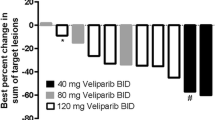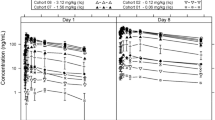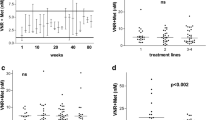Abstract
Purpose: An all-oral regimen of etoposide and cyclophosphamide was developed for use in poor-prognosis extensive disease small-cell lung cancer. Limited pharmacokinetic sampling was used to derive a pharmacodynamic model predictive of myelosuppression early in the course of therapy. Patients and methods: Eligible patients were chemotherapy-naive and had extensive disease small-cell lung cancer with either SWOG performance status 2 or serum albumin <3.5 g/dl. The first cohort (n = 18) received etoposide orally at 50 mg daily and cyclophosphamide orally at 50 mg daily days 1–14 every 28 days. Due to good hematologic tolerance, the second cohort (n = 39) received both agents orally at 50 mg twice daily days 1–14 every 28 days. Plasma etoposide levels were determined in samples drawn at baseline, and at 1 h, 2 h, and 23.5 h (trough) after the first dose. Linear regression analysis was used to determine pharmacokinetic and demographic parameters predictive of myelosuppression. Results: A total of 173 treatment cycles were delivered. Patients on the daily regimen had a 22% response rate (complete and partial), a 22% unconfirmed response rate, and a 5-month median survival, while patients on the twice-daily regimen had a 28% response rate (complete and partial), a 13% unconfirmed response rate, and a 7-month median survival. Granulocytopenia and alopecia were the most common toxicities seen. Significant granulocytopenia could be predicted for the twice-daily regimen according to the formula ln(AGC nadir)=7.80 − 1.88(trough), with an increased incidence of granulocytopenia if the etoposide trough value was ≥1.49 μg/ml. Conclusion: Oral etoposide and oral cyclophosphamide given days 1–14 every 28 days is well tolerated and results in an acceptable response rate and median survival in poor-prognosis (poor performance status or low serum albumin) extensive disease small-cell lung cancer. A trough etoposide level obtained within 24 h of starting therapy can predict severe granulocytopenia.
Similar content being viewed by others
Author information
Authors and Affiliations
Additional information
Received: 27 October 1998 / Accepted: 3 May 1999
Rights and permissions
About this article
Cite this article
Grunberg, S., Crowley, J., Hande, K. et al. Treatment of poor-prognosis extensive disease small-cell lung cancer with an all-oral regimen of etoposide and cyclophosphamide – a Southwest Oncology Group clinical and pharmacokinetic study. Cancer Chemother Pharmacol 44, 461–468 (1999). https://doi.org/10.1007/s002800051119
Issue Date:
DOI: https://doi.org/10.1007/s002800051119




